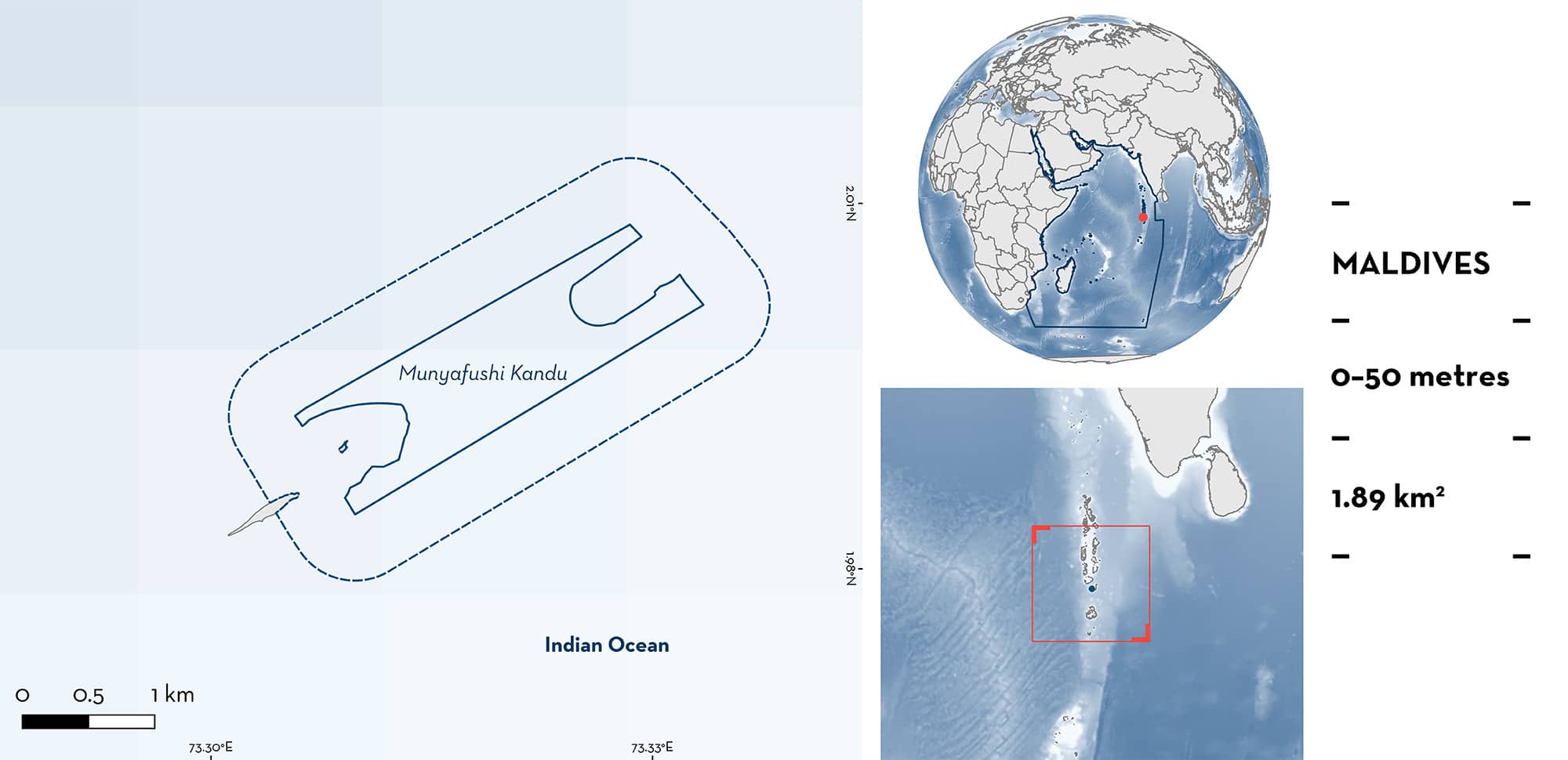ISRA FACTSHEETS
ISRA FACTSHEETS
WESTERN INDIAN OCEAN REGION
Munyafushi Kandu
Summary
Munyafushi Kandu is located in northwestern Laamu Atoll in the southern Maldives. This area is a channel which connects the open ocean to the atoll lagoon. The area is subject to high current flow. Within this area there are: threatened species (e.g., Whitetip Reef Shark Triaenodon obesus); and undefined aggregations (e.g., Grey Reef Shark Carcharhinus amblyrhynchos).
Download factsheet
Munyafushi Kandu
DESCRIPTION OF HABITAT
Munyafushi Kandu is located in the southern Maldives archipelago which sits centrally on the Chagos-Laccadive Ridge (Stevens & Froman 2019). This area (also known as Munyafushi Channel) is a channel in the northwestern side of Laamu Atoll. Channels, locally known as kandu, are reef passes that connect the open ocean to the atoll lagoon. These channels are known for their high current flow (Stevens & Froman 2019).
The weather in the Maldives is strongly influenced by the South Asian monsoon, especially the northern and central atolls as these are closer to the Indian subcontinent (Anderson et al. 2011). Therefore, two monsoons occur annually in Maldives. The southwest monsoon (locally known as Hulhan’gu), from May to November, and the northeast monsoon (locally known as Iruvai), from January to March, with transitional periods in December and April (Shankar et al. 2002; Anderson et al. 2011). The southwest monsoon increases average rainfall, and wind speeds, causing rougher seas and reduced visibility; in contrast, the northeast monsoon usually brings clear waters (Stevens & Froman 2019).
The Maldives archipelago disrupts the flow of the monsoon-driven North Equatorial Current as it crosses the Indian Ocean (Schott & McCreary 2001) which creates a current flow through the Maldives’ channels (Sasamal 2006). The strongest lunar currents can overcome the prevailing monsoonal currents through the tidal suction mechanism along the channel’s outer edges (Stevens 2016).
This Important Shark and Ray Area is benthopelagic and is delineated from 0 to 50 m based on the depth range of Qualifying Species in this area.
CRITERION A
VULNERABILITY
Two Qualifying Species considered threatened with extinction according to the IUCN Red List of Threatened SpeciesTM regularly occur in the area. These are the Endangered Grey Reef Shark (Simpfendorfer et al. 2020a) and the Vulnerable Whitetip Reef Shark (Simpfendorfer et al. 2020b).
CRITERION C
SUB-CRITERION C5 – UNDEFINED AGGREGATIONS
This area is important for undefined aggregations of two shark species.
Data were collected from a citizen-science program known as the Sharkwatch project which was a government-led initiative run between 2009–2019 (Maldives Marine Research Institute [MMRI], unpubl. data 2023). Data were reported by experienced dive guides using the roving diver technique where surveyors can swim in any direction and count the number of individuals encountered by species during one-hour dive surveys. From the ~1,110 sites surveyed in the Maldives, this area has been identified as one of the most important aggregations for Whitetip Reef Shark and Grey Reef Shark (MMRI unpubl. data 2023). Sharkwatch surveys were conducted over five years (2013–2017; n = 33) in this area.
Sharkwatch surveys estimated a mean encounter rate of nine Whitetip Reef Sharks/hour (MMRI unpubl. data 2023). On six surveys in 2017, aggregations of >15 Whitetip Reef Sharks/hour were recorded, in which five surveys conducted during the southwest monsoon recorded >20 Whitetip Reef Sharks/hour (MMRI unpubl. data 2023).
Sharkwatch surveys estimated a mean encounter rate of 11 Grey Reef Sharks/hour (MMRI unpubl. data 2023). In 2013 and 2017, aggregations of >30 Grey Reef Sharks/hour were recorded in four surveys, where during two surveys in 2017, >60 Grey Reef Sharks/hour were recorded. Grey Reef Sharks are observed in both monsoon seasons. For example, for both monsoon seasons in 2017, encounter rates of >20 Grey Reef Sharks/hour were observed during multiple surveys (MMRI unpubl. data 2023). This area might be used as a resting ground for the Grey Reef Shark. In channels with strong currents in French Polynesia, Grey Reef Sharks use current-induced updraft zones to reduce energy expenditure, since these are negatively buoyant fishes and obligate swimmers (Papastamatiou et al. 2021). Further information is required to determine the nature and function of these aggregations.
Download factsheet
SUBMIT A REQUEST
ISRA SPATIAL LAYER REQUEST
To make a request to download the ISRA Layer in either a GIS compatible Shapefile (.shp) or Google Earth compatible Keyhole Markup Language Zipped file (.kmz) please complete the following form. We will review your request and send the download details to you. We will endeavor to send you the requested files as soon as we can. However, please note that this is not an automated process, and before requests are responded to, they undergo internal review and authorization. As such, requests normally take 5–10 working days to process.
Should you have questions about the data or process, please do not hesitate to contact us.


